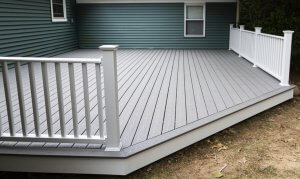If you’ve noticed some issues with your deck, such as loose floorboards, you may be wondering whether it is time to repair or replace your deck. At Quaker State Construction, we have put together some tips on what to look for when evaluating your deck to help you determine if it can be repaired or if it will need to be replaced.
When doing your own inspection of your deck, there are four main areas that you need to look at, including:
Deck posts- These are the vertical parts of your deck’s substructure used to hold it up on the ground. Since they are vertical, they don’t receive a lot of UV light or water damage. Two placed to check for water accumulation include the base of the post where it rests on the footer and the place where the beams attach to the post. Check these areas for signs of rot.
The surface of the deck- Check the handrails, deck boards, and railings. These wooden surfaces are exposed to moisture and can rot. UV rays can also fade the colors of the wood and cause damage to the wood fibers, which makes it easier for the water to penetrate the wood.
Fascia board- This is a wide, thin board that goes around the perimeter of your deck. It is located either just below your deck boards or conceals the ends of the deck boards. This board is not structural, but it helps give your deck a neater appearance. The fascia can sometimes trap water and cause rot. If you see discoloration on your deck boards around the deck perimeter, your fascia board could be trapping water and causing rot to the boards.
Beams and joists- These are the horizontal pieces of wood that support the deck boards. These are the larger beams with joists running between them. These horizontal boards tend to rot at the ends where it joins the other wood on the deck. This joint can trap moisture, and the fasteners give the water a place to penetrate the wood.
If the cost of your deck repairs is starting to add up to the cost of replacing your deck, then it is time to consider a replacement of the entire deck. Even if your materials appear structurally sound, they may still be old and may end up needing to be replaced within a few more years. So it is important to find where to draw the line between repairs and replacement.
If you have a single rotten post, it can be a hassle to replace since the surrounding beams need temporary supports during the replacement of the board, but it doesn’t justify replacing your entire deck. Even if you need to replace multiple posts, it shouldn’t add up to the cost of a new deck. However, if your posts are buried in the ground rather than resting on footers, it can shorten the longevity of the posts. It is recommended that you consider a rebuild of your deck utilizing footers.
Posts are a simple repair, but when it comes to beams, it can be more difficult. The beams work by holding the joists, which support the deck boards. If you must remove a beam, you will also need to remove multiple joists. In many cases, if you are replacing a beam, you are likely replacing large sections of the deck. It is best for these replacements to be performed by a professional. When you consider the cost of hired labor, it may end up being cheaper to replace the deck. If you have water trapped behind your fascia board, it is likely the beam has also been affected. If that is the case, replacing the deck is more feasible.

Whether you’ve deiced to have your deck repaired or replaced, it is important to choose the right materials for a long-lasting deck. At Quaker State Construction, we utilize the following materials to ensure your replacement deck is built to last:
Contact Quaker State Construction today to learn more about our extreme deck makeover!